THE NURSING ASSIGNMENT
VerifiedAdded on 2022/09/08
|11
|3434
|28
AI Summary
Contribute Materials
Your contribution can guide someone’s learning journey. Share your
documents today.
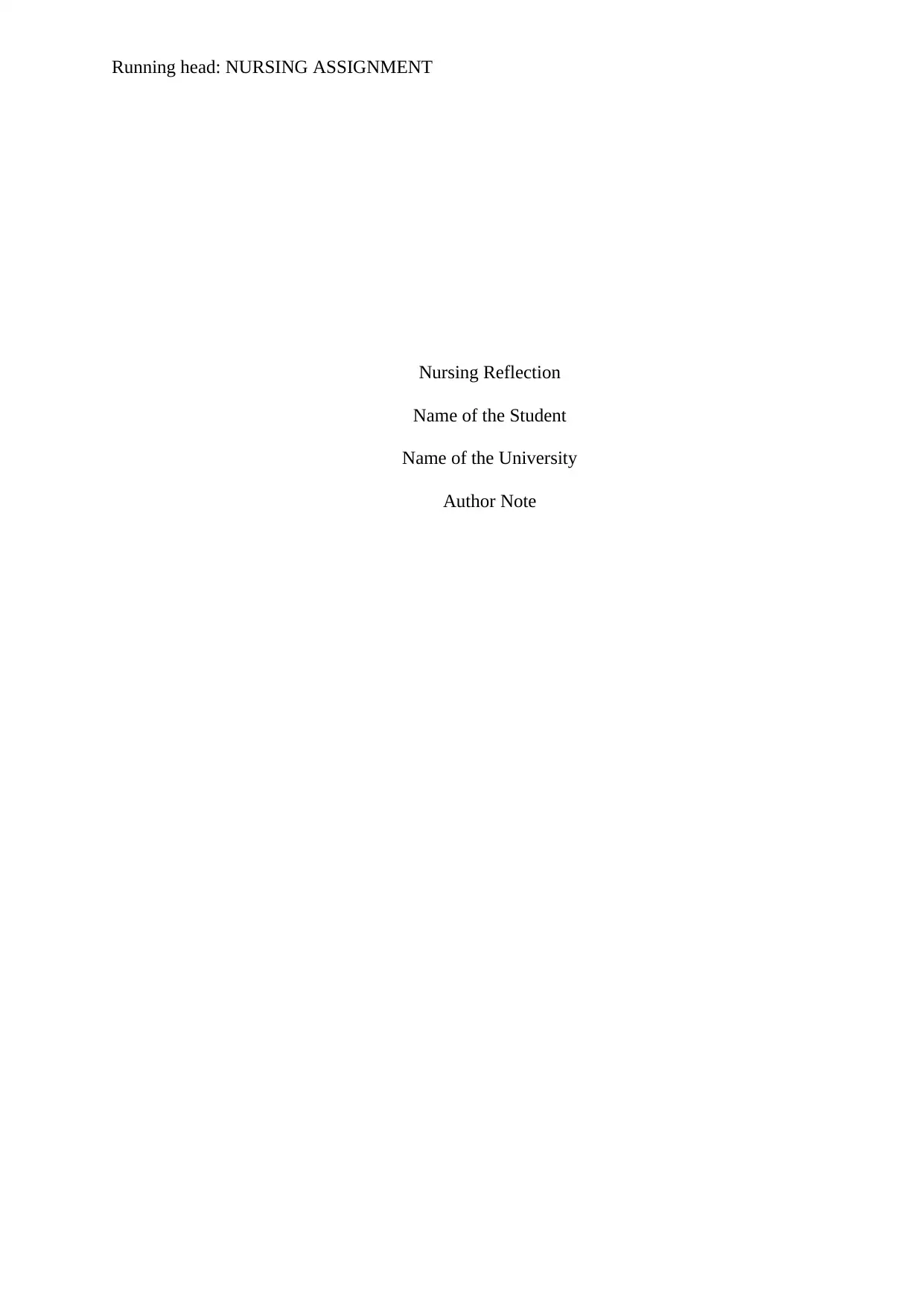
Running head: NURSING ASSIGNMENT
Nursing Reflection
Name of the Student
Name of the University
Author Note
Nursing Reflection
Name of the Student
Name of the University
Author Note
Secure Best Marks with AI Grader
Need help grading? Try our AI Grader for instant feedback on your assignments.
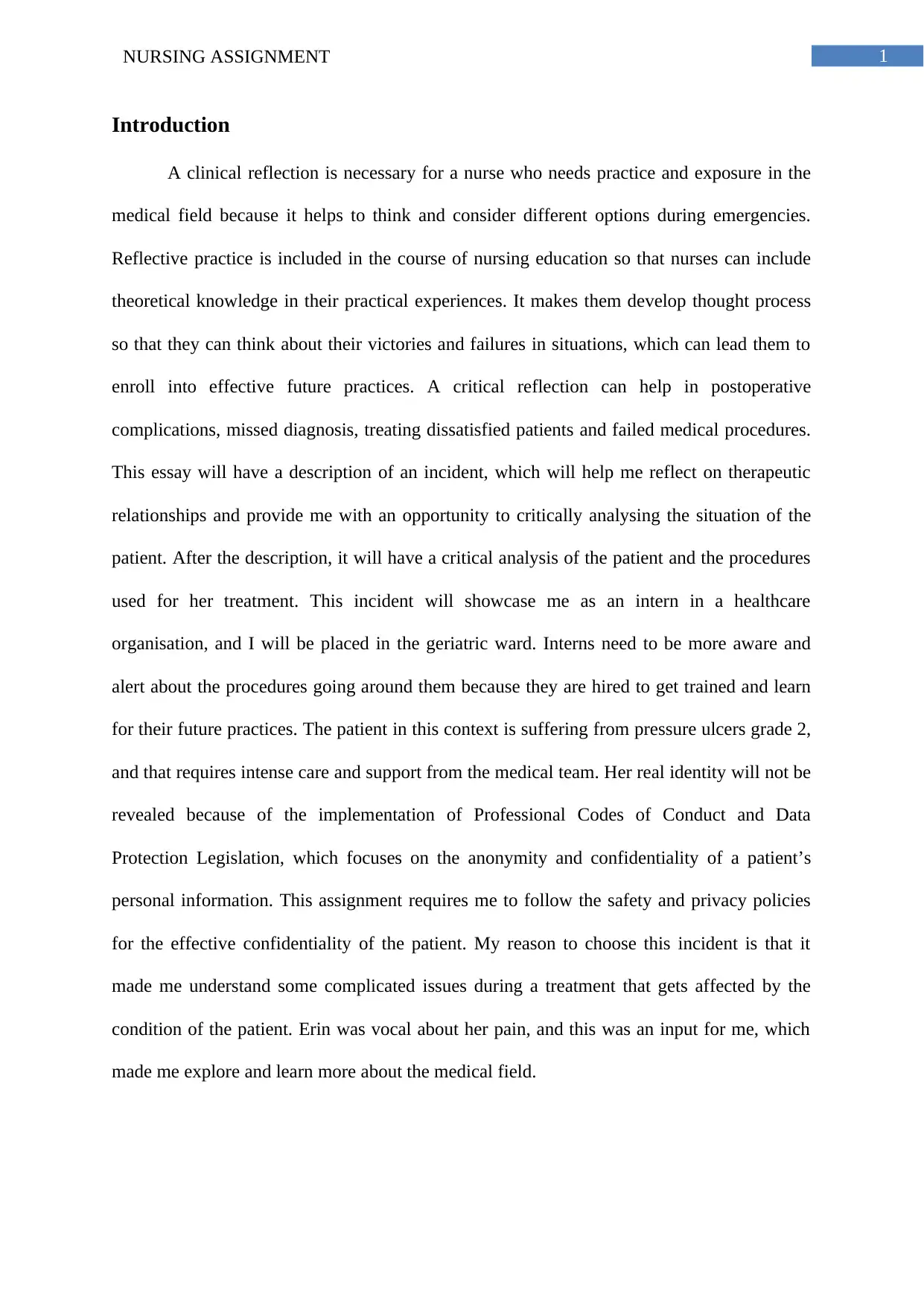
1NURSING ASSIGNMENT
Introduction
A clinical reflection is necessary for a nurse who needs practice and exposure in the
medical field because it helps to think and consider different options during emergencies.
Reflective practice is included in the course of nursing education so that nurses can include
theoretical knowledge in their practical experiences. It makes them develop thought process
so that they can think about their victories and failures in situations, which can lead them to
enroll into effective future practices. A critical reflection can help in postoperative
complications, missed diagnosis, treating dissatisfied patients and failed medical procedures.
This essay will have a description of an incident, which will help me reflect on therapeutic
relationships and provide me with an opportunity to critically analysing the situation of the
patient. After the description, it will have a critical analysis of the patient and the procedures
used for her treatment. This incident will showcase me as an intern in a healthcare
organisation, and I will be placed in the geriatric ward. Interns need to be more aware and
alert about the procedures going around them because they are hired to get trained and learn
for their future practices. The patient in this context is suffering from pressure ulcers grade 2,
and that requires intense care and support from the medical team. Her real identity will not be
revealed because of the implementation of Professional Codes of Conduct and Data
Protection Legislation, which focuses on the anonymity and confidentiality of a patient’s
personal information. This assignment requires me to follow the safety and privacy policies
for the effective confidentiality of the patient. My reason to choose this incident is that it
made me understand some complicated issues during a treatment that gets affected by the
condition of the patient. Erin was vocal about her pain, and this was an input for me, which
made me explore and learn more about the medical field.
Introduction
A clinical reflection is necessary for a nurse who needs practice and exposure in the
medical field because it helps to think and consider different options during emergencies.
Reflective practice is included in the course of nursing education so that nurses can include
theoretical knowledge in their practical experiences. It makes them develop thought process
so that they can think about their victories and failures in situations, which can lead them to
enroll into effective future practices. A critical reflection can help in postoperative
complications, missed diagnosis, treating dissatisfied patients and failed medical procedures.
This essay will have a description of an incident, which will help me reflect on therapeutic
relationships and provide me with an opportunity to critically analysing the situation of the
patient. After the description, it will have a critical analysis of the patient and the procedures
used for her treatment. This incident will showcase me as an intern in a healthcare
organisation, and I will be placed in the geriatric ward. Interns need to be more aware and
alert about the procedures going around them because they are hired to get trained and learn
for their future practices. The patient in this context is suffering from pressure ulcers grade 2,
and that requires intense care and support from the medical team. Her real identity will not be
revealed because of the implementation of Professional Codes of Conduct and Data
Protection Legislation, which focuses on the anonymity and confidentiality of a patient’s
personal information. This assignment requires me to follow the safety and privacy policies
for the effective confidentiality of the patient. My reason to choose this incident is that it
made me understand some complicated issues during a treatment that gets affected by the
condition of the patient. Erin was vocal about her pain, and this was an input for me, which
made me explore and learn more about the medical field.
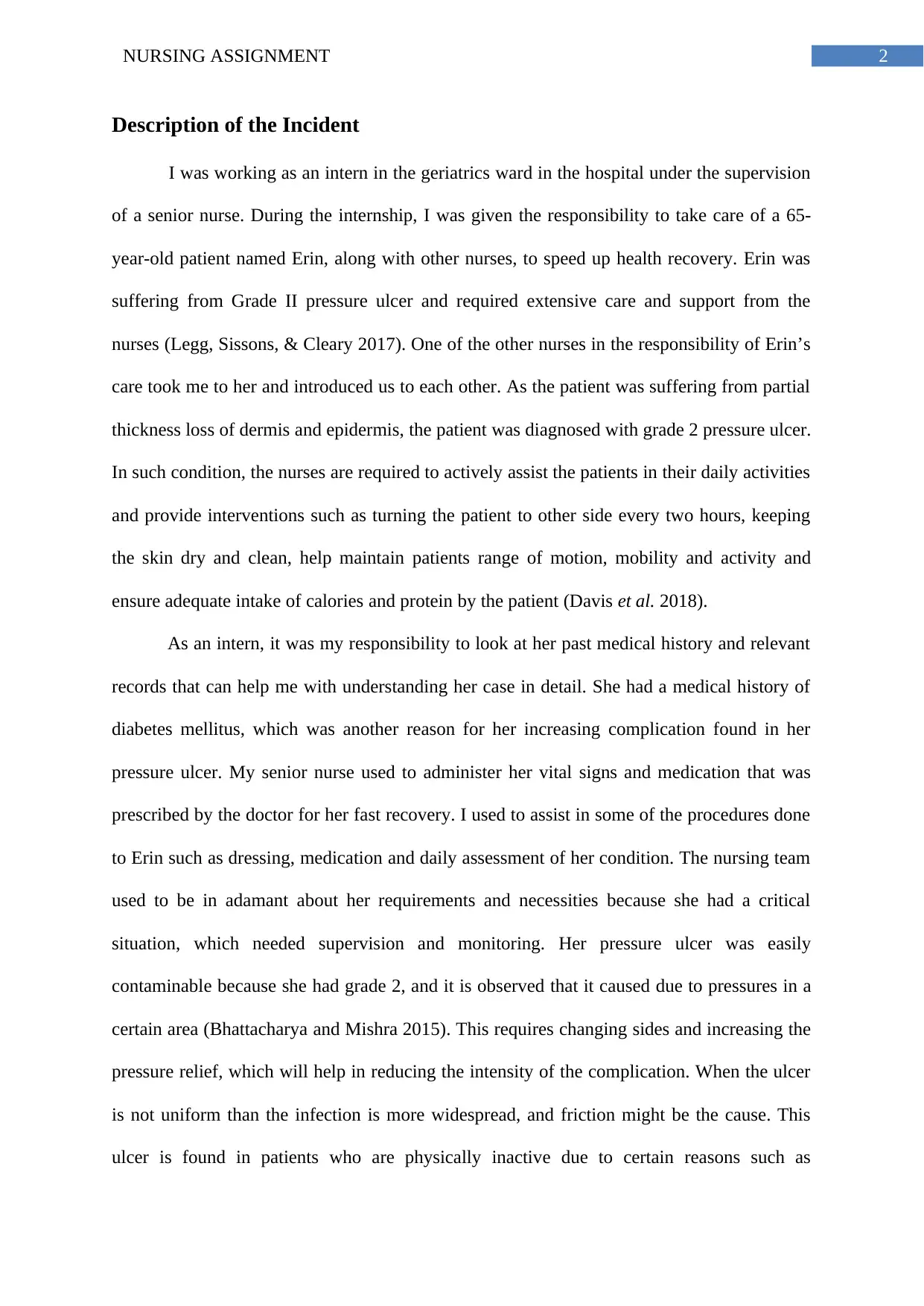
2NURSING ASSIGNMENT
Description of the Incident
I was working as an intern in the geriatrics ward in the hospital under the supervision
of a senior nurse. During the internship, I was given the responsibility to take care of a 65-
year-old patient named Erin, along with other nurses, to speed up health recovery. Erin was
suffering from Grade II pressure ulcer and required extensive care and support from the
nurses (Legg, Sissons, & Cleary 2017). One of the other nurses in the responsibility of Erin’s
care took me to her and introduced us to each other. As the patient was suffering from partial
thickness loss of dermis and epidermis, the patient was diagnosed with grade 2 pressure ulcer.
In such condition, the nurses are required to actively assist the patients in their daily activities
and provide interventions such as turning the patient to other side every two hours, keeping
the skin dry and clean, help maintain patients range of motion, mobility and activity and
ensure adequate intake of calories and protein by the patient (Davis et al. 2018).
As an intern, it was my responsibility to look at her past medical history and relevant
records that can help me with understanding her case in detail. She had a medical history of
diabetes mellitus, which was another reason for her increasing complication found in her
pressure ulcer. My senior nurse used to administer her vital signs and medication that was
prescribed by the doctor for her fast recovery. I used to assist in some of the procedures done
to Erin such as dressing, medication and daily assessment of her condition. The nursing team
used to be in adamant about her requirements and necessities because she had a critical
situation, which needed supervision and monitoring. Her pressure ulcer was easily
contaminable because she had grade 2, and it is observed that it caused due to pressures in a
certain area (Bhattacharya and Mishra 2015). This requires changing sides and increasing the
pressure relief, which will help in reducing the intensity of the complication. When the ulcer
is not uniform than the infection is more widespread, and friction might be the cause. This
ulcer is found in patients who are physically inactive due to certain reasons such as
Description of the Incident
I was working as an intern in the geriatrics ward in the hospital under the supervision
of a senior nurse. During the internship, I was given the responsibility to take care of a 65-
year-old patient named Erin, along with other nurses, to speed up health recovery. Erin was
suffering from Grade II pressure ulcer and required extensive care and support from the
nurses (Legg, Sissons, & Cleary 2017). One of the other nurses in the responsibility of Erin’s
care took me to her and introduced us to each other. As the patient was suffering from partial
thickness loss of dermis and epidermis, the patient was diagnosed with grade 2 pressure ulcer.
In such condition, the nurses are required to actively assist the patients in their daily activities
and provide interventions such as turning the patient to other side every two hours, keeping
the skin dry and clean, help maintain patients range of motion, mobility and activity and
ensure adequate intake of calories and protein by the patient (Davis et al. 2018).
As an intern, it was my responsibility to look at her past medical history and relevant
records that can help me with understanding her case in detail. She had a medical history of
diabetes mellitus, which was another reason for her increasing complication found in her
pressure ulcer. My senior nurse used to administer her vital signs and medication that was
prescribed by the doctor for her fast recovery. I used to assist in some of the procedures done
to Erin such as dressing, medication and daily assessment of her condition. The nursing team
used to be in adamant about her requirements and necessities because she had a critical
situation, which needed supervision and monitoring. Her pressure ulcer was easily
contaminable because she had grade 2, and it is observed that it caused due to pressures in a
certain area (Bhattacharya and Mishra 2015). This requires changing sides and increasing the
pressure relief, which will help in reducing the intensity of the complication. When the ulcer
is not uniform than the infection is more widespread, and friction might be the cause. This
ulcer is found in patients who are physically inactive due to certain reasons such as
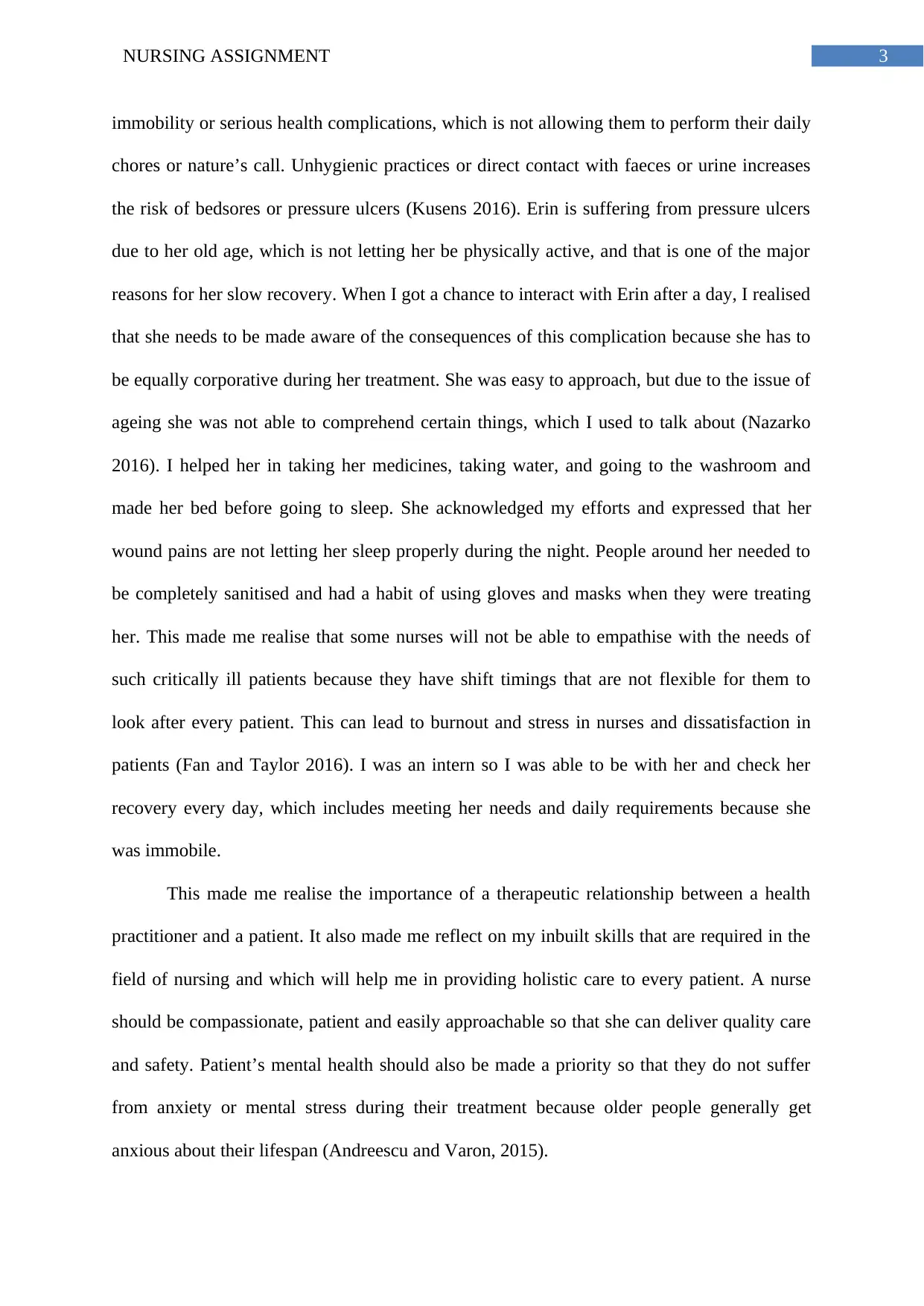
3NURSING ASSIGNMENT
immobility or serious health complications, which is not allowing them to perform their daily
chores or nature’s call. Unhygienic practices or direct contact with faeces or urine increases
the risk of bedsores or pressure ulcers (Kusens 2016). Erin is suffering from pressure ulcers
due to her old age, which is not letting her be physically active, and that is one of the major
reasons for her slow recovery. When I got a chance to interact with Erin after a day, I realised
that she needs to be made aware of the consequences of this complication because she has to
be equally corporative during her treatment. She was easy to approach, but due to the issue of
ageing she was not able to comprehend certain things, which I used to talk about (Nazarko
2016). I helped her in taking her medicines, taking water, and going to the washroom and
made her bed before going to sleep. She acknowledged my efforts and expressed that her
wound pains are not letting her sleep properly during the night. People around her needed to
be completely sanitised and had a habit of using gloves and masks when they were treating
her. This made me realise that some nurses will not be able to empathise with the needs of
such critically ill patients because they have shift timings that are not flexible for them to
look after every patient. This can lead to burnout and stress in nurses and dissatisfaction in
patients (Fan and Taylor 2016). I was an intern so I was able to be with her and check her
recovery every day, which includes meeting her needs and daily requirements because she
was immobile.
This made me realise the importance of a therapeutic relationship between a health
practitioner and a patient. It also made me reflect on my inbuilt skills that are required in the
field of nursing and which will help me in providing holistic care to every patient. A nurse
should be compassionate, patient and easily approachable so that she can deliver quality care
and safety. Patient’s mental health should also be made a priority so that they do not suffer
from anxiety or mental stress during their treatment because older people generally get
anxious about their lifespan (Andreescu and Varon, 2015).
immobility or serious health complications, which is not allowing them to perform their daily
chores or nature’s call. Unhygienic practices or direct contact with faeces or urine increases
the risk of bedsores or pressure ulcers (Kusens 2016). Erin is suffering from pressure ulcers
due to her old age, which is not letting her be physically active, and that is one of the major
reasons for her slow recovery. When I got a chance to interact with Erin after a day, I realised
that she needs to be made aware of the consequences of this complication because she has to
be equally corporative during her treatment. She was easy to approach, but due to the issue of
ageing she was not able to comprehend certain things, which I used to talk about (Nazarko
2016). I helped her in taking her medicines, taking water, and going to the washroom and
made her bed before going to sleep. She acknowledged my efforts and expressed that her
wound pains are not letting her sleep properly during the night. People around her needed to
be completely sanitised and had a habit of using gloves and masks when they were treating
her. This made me realise that some nurses will not be able to empathise with the needs of
such critically ill patients because they have shift timings that are not flexible for them to
look after every patient. This can lead to burnout and stress in nurses and dissatisfaction in
patients (Fan and Taylor 2016). I was an intern so I was able to be with her and check her
recovery every day, which includes meeting her needs and daily requirements because she
was immobile.
This made me realise the importance of a therapeutic relationship between a health
practitioner and a patient. It also made me reflect on my inbuilt skills that are required in the
field of nursing and which will help me in providing holistic care to every patient. A nurse
should be compassionate, patient and easily approachable so that she can deliver quality care
and safety. Patient’s mental health should also be made a priority so that they do not suffer
from anxiety or mental stress during their treatment because older people generally get
anxious about their lifespan (Andreescu and Varon, 2015).
Secure Best Marks with AI Grader
Need help grading? Try our AI Grader for instant feedback on your assignments.
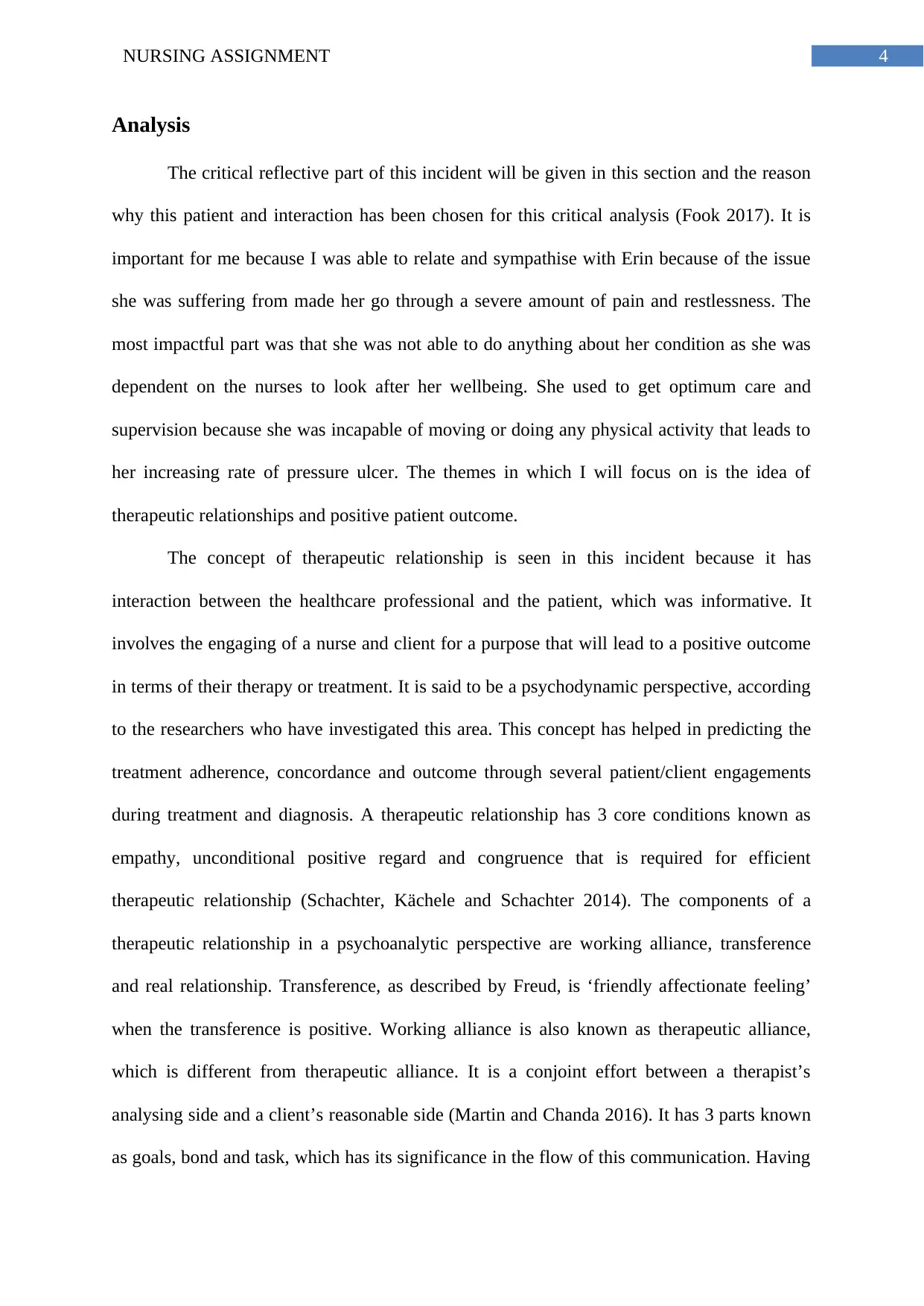
4NURSING ASSIGNMENT
Analysis
The critical reflective part of this incident will be given in this section and the reason
why this patient and interaction has been chosen for this critical analysis (Fook 2017). It is
important for me because I was able to relate and sympathise with Erin because of the issue
she was suffering from made her go through a severe amount of pain and restlessness. The
most impactful part was that she was not able to do anything about her condition as she was
dependent on the nurses to look after her wellbeing. She used to get optimum care and
supervision because she was incapable of moving or doing any physical activity that leads to
her increasing rate of pressure ulcer. The themes in which I will focus on is the idea of
therapeutic relationships and positive patient outcome.
The concept of therapeutic relationship is seen in this incident because it has
interaction between the healthcare professional and the patient, which was informative. It
involves the engaging of a nurse and client for a purpose that will lead to a positive outcome
in terms of their therapy or treatment. It is said to be a psychodynamic perspective, according
to the researchers who have investigated this area. This concept has helped in predicting the
treatment adherence, concordance and outcome through several patient/client engagements
during treatment and diagnosis. A therapeutic relationship has 3 core conditions known as
empathy, unconditional positive regard and congruence that is required for efficient
therapeutic relationship (Schachter, Kächele and Schachter 2014). The components of a
therapeutic relationship in a psychoanalytic perspective are working alliance, transference
and real relationship. Transference, as described by Freud, is ‘friendly affectionate feeling’
when the transference is positive. Working alliance is also known as therapeutic alliance,
which is different from therapeutic alliance. It is a conjoint effort between a therapist’s
analysing side and a client’s reasonable side (Martin and Chanda 2016). It has 3 parts known
as goals, bond and task, which has its significance in the flow of this communication. Having
Analysis
The critical reflective part of this incident will be given in this section and the reason
why this patient and interaction has been chosen for this critical analysis (Fook 2017). It is
important for me because I was able to relate and sympathise with Erin because of the issue
she was suffering from made her go through a severe amount of pain and restlessness. The
most impactful part was that she was not able to do anything about her condition as she was
dependent on the nurses to look after her wellbeing. She used to get optimum care and
supervision because she was incapable of moving or doing any physical activity that leads to
her increasing rate of pressure ulcer. The themes in which I will focus on is the idea of
therapeutic relationships and positive patient outcome.
The concept of therapeutic relationship is seen in this incident because it has
interaction between the healthcare professional and the patient, which was informative. It
involves the engaging of a nurse and client for a purpose that will lead to a positive outcome
in terms of their therapy or treatment. It is said to be a psychodynamic perspective, according
to the researchers who have investigated this area. This concept has helped in predicting the
treatment adherence, concordance and outcome through several patient/client engagements
during treatment and diagnosis. A therapeutic relationship has 3 core conditions known as
empathy, unconditional positive regard and congruence that is required for efficient
therapeutic relationship (Schachter, Kächele and Schachter 2014). The components of a
therapeutic relationship in a psychoanalytic perspective are working alliance, transference
and real relationship. Transference, as described by Freud, is ‘friendly affectionate feeling’
when the transference is positive. Working alliance is also known as therapeutic alliance,
which is different from therapeutic alliance. It is a conjoint effort between a therapist’s
analysing side and a client’s reasonable side (Martin and Chanda 2016). It has 3 parts known
as goals, bond and task, which has its significance in the flow of this communication. Having
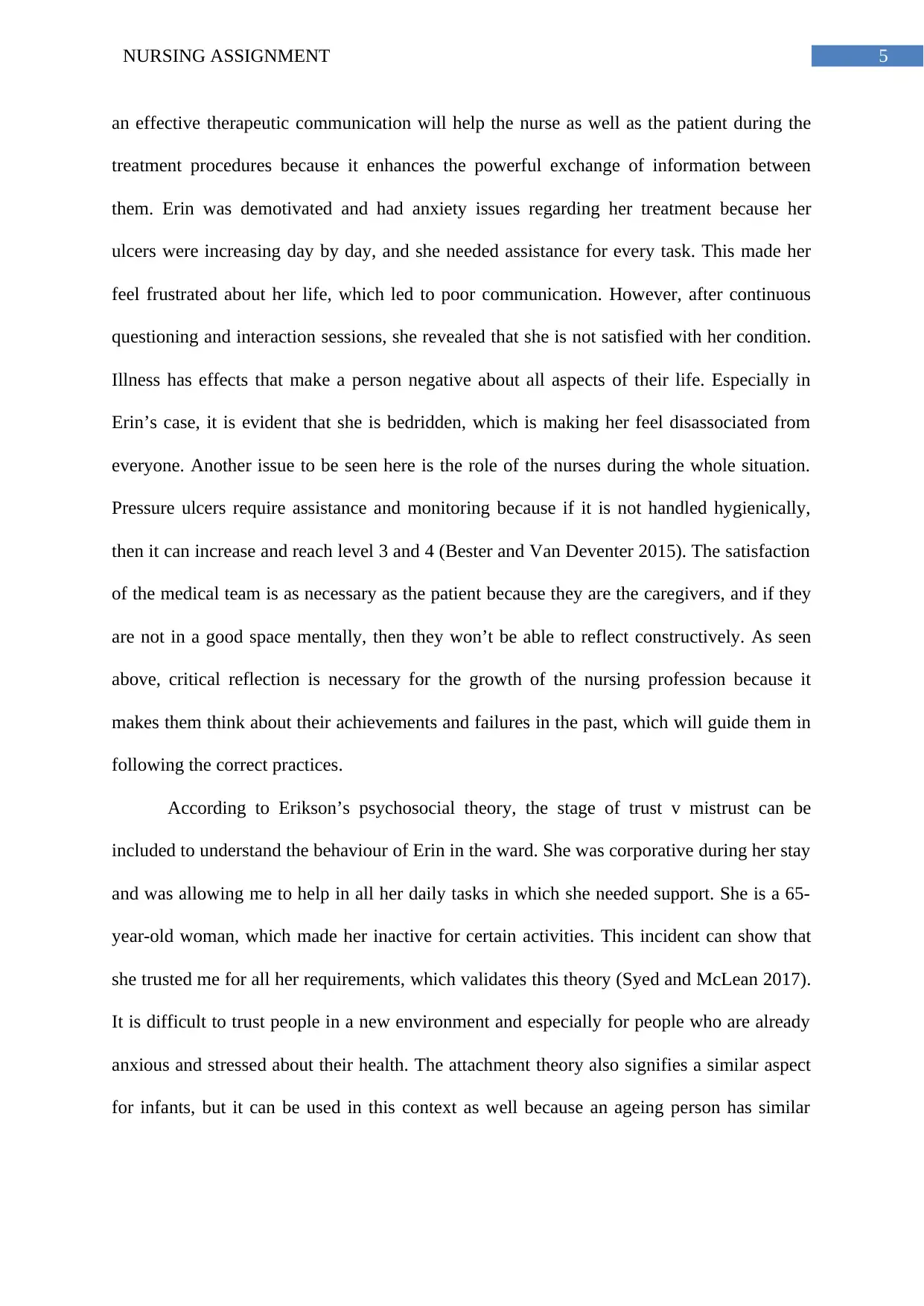
5NURSING ASSIGNMENT
an effective therapeutic communication will help the nurse as well as the patient during the
treatment procedures because it enhances the powerful exchange of information between
them. Erin was demotivated and had anxiety issues regarding her treatment because her
ulcers were increasing day by day, and she needed assistance for every task. This made her
feel frustrated about her life, which led to poor communication. However, after continuous
questioning and interaction sessions, she revealed that she is not satisfied with her condition.
Illness has effects that make a person negative about all aspects of their life. Especially in
Erin’s case, it is evident that she is bedridden, which is making her feel disassociated from
everyone. Another issue to be seen here is the role of the nurses during the whole situation.
Pressure ulcers require assistance and monitoring because if it is not handled hygienically,
then it can increase and reach level 3 and 4 (Bester and Van Deventer 2015). The satisfaction
of the medical team is as necessary as the patient because they are the caregivers, and if they
are not in a good space mentally, then they won’t be able to reflect constructively. As seen
above, critical reflection is necessary for the growth of the nursing profession because it
makes them think about their achievements and failures in the past, which will guide them in
following the correct practices.
According to Erikson’s psychosocial theory, the stage of trust v mistrust can be
included to understand the behaviour of Erin in the ward. She was corporative during her stay
and was allowing me to help in all her daily tasks in which she needed support. She is a 65-
year-old woman, which made her inactive for certain activities. This incident can show that
she trusted me for all her requirements, which validates this theory (Syed and McLean 2017).
It is difficult to trust people in a new environment and especially for people who are already
anxious and stressed about their health. The attachment theory also signifies a similar aspect
for infants, but it can be used in this context as well because an ageing person has similar
an effective therapeutic communication will help the nurse as well as the patient during the
treatment procedures because it enhances the powerful exchange of information between
them. Erin was demotivated and had anxiety issues regarding her treatment because her
ulcers were increasing day by day, and she needed assistance for every task. This made her
feel frustrated about her life, which led to poor communication. However, after continuous
questioning and interaction sessions, she revealed that she is not satisfied with her condition.
Illness has effects that make a person negative about all aspects of their life. Especially in
Erin’s case, it is evident that she is bedridden, which is making her feel disassociated from
everyone. Another issue to be seen here is the role of the nurses during the whole situation.
Pressure ulcers require assistance and monitoring because if it is not handled hygienically,
then it can increase and reach level 3 and 4 (Bester and Van Deventer 2015). The satisfaction
of the medical team is as necessary as the patient because they are the caregivers, and if they
are not in a good space mentally, then they won’t be able to reflect constructively. As seen
above, critical reflection is necessary for the growth of the nursing profession because it
makes them think about their achievements and failures in the past, which will guide them in
following the correct practices.
According to Erikson’s psychosocial theory, the stage of trust v mistrust can be
included to understand the behaviour of Erin in the ward. She was corporative during her stay
and was allowing me to help in all her daily tasks in which she needed support. She is a 65-
year-old woman, which made her inactive for certain activities. This incident can show that
she trusted me for all her requirements, which validates this theory (Syed and McLean 2017).
It is difficult to trust people in a new environment and especially for people who are already
anxious and stressed about their health. The attachment theory also signifies a similar aspect
for infants, but it can be used in this context as well because an ageing person has similar
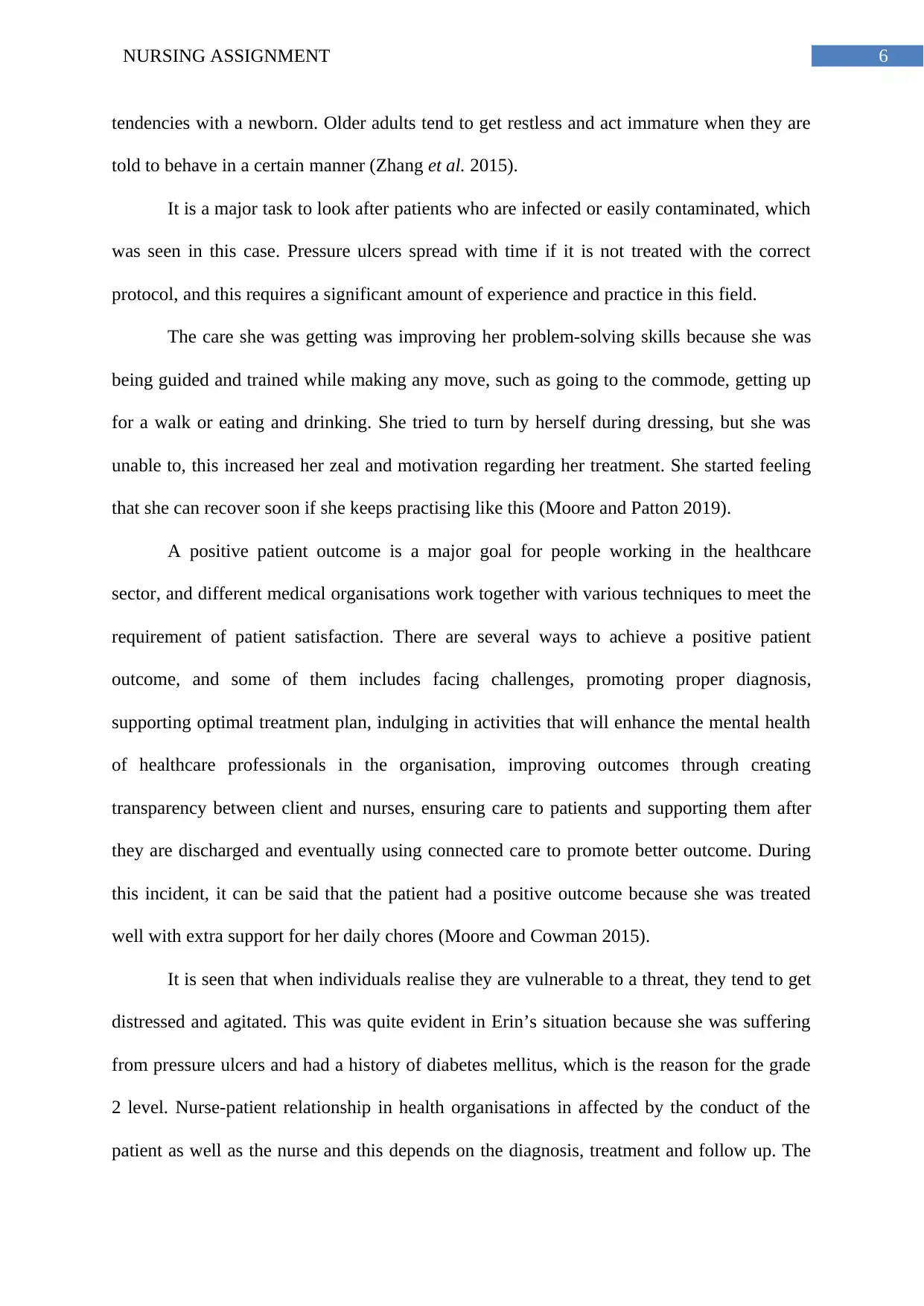
6NURSING ASSIGNMENT
tendencies with a newborn. Older adults tend to get restless and act immature when they are
told to behave in a certain manner (Zhang et al. 2015).
It is a major task to look after patients who are infected or easily contaminated, which
was seen in this case. Pressure ulcers spread with time if it is not treated with the correct
protocol, and this requires a significant amount of experience and practice in this field.
The care she was getting was improving her problem-solving skills because she was
being guided and trained while making any move, such as going to the commode, getting up
for a walk or eating and drinking. She tried to turn by herself during dressing, but she was
unable to, this increased her zeal and motivation regarding her treatment. She started feeling
that she can recover soon if she keeps practising like this (Moore and Patton 2019).
A positive patient outcome is a major goal for people working in the healthcare
sector, and different medical organisations work together with various techniques to meet the
requirement of patient satisfaction. There are several ways to achieve a positive patient
outcome, and some of them includes facing challenges, promoting proper diagnosis,
supporting optimal treatment plan, indulging in activities that will enhance the mental health
of healthcare professionals in the organisation, improving outcomes through creating
transparency between client and nurses, ensuring care to patients and supporting them after
they are discharged and eventually using connected care to promote better outcome. During
this incident, it can be said that the patient had a positive outcome because she was treated
well with extra support for her daily chores (Moore and Cowman 2015).
It is seen that when individuals realise they are vulnerable to a threat, they tend to get
distressed and agitated. This was quite evident in Erin’s situation because she was suffering
from pressure ulcers and had a history of diabetes mellitus, which is the reason for the grade
2 level. Nurse-patient relationship in health organisations in affected by the conduct of the
patient as well as the nurse and this depends on the diagnosis, treatment and follow up. The
tendencies with a newborn. Older adults tend to get restless and act immature when they are
told to behave in a certain manner (Zhang et al. 2015).
It is a major task to look after patients who are infected or easily contaminated, which
was seen in this case. Pressure ulcers spread with time if it is not treated with the correct
protocol, and this requires a significant amount of experience and practice in this field.
The care she was getting was improving her problem-solving skills because she was
being guided and trained while making any move, such as going to the commode, getting up
for a walk or eating and drinking. She tried to turn by herself during dressing, but she was
unable to, this increased her zeal and motivation regarding her treatment. She started feeling
that she can recover soon if she keeps practising like this (Moore and Patton 2019).
A positive patient outcome is a major goal for people working in the healthcare
sector, and different medical organisations work together with various techniques to meet the
requirement of patient satisfaction. There are several ways to achieve a positive patient
outcome, and some of them includes facing challenges, promoting proper diagnosis,
supporting optimal treatment plan, indulging in activities that will enhance the mental health
of healthcare professionals in the organisation, improving outcomes through creating
transparency between client and nurses, ensuring care to patients and supporting them after
they are discharged and eventually using connected care to promote better outcome. During
this incident, it can be said that the patient had a positive outcome because she was treated
well with extra support for her daily chores (Moore and Cowman 2015).
It is seen that when individuals realise they are vulnerable to a threat, they tend to get
distressed and agitated. This was quite evident in Erin’s situation because she was suffering
from pressure ulcers and had a history of diabetes mellitus, which is the reason for the grade
2 level. Nurse-patient relationship in health organisations in affected by the conduct of the
patient as well as the nurse and this depends on the diagnosis, treatment and follow up. The
Paraphrase This Document
Need a fresh take? Get an instant paraphrase of this document with our AI Paraphraser
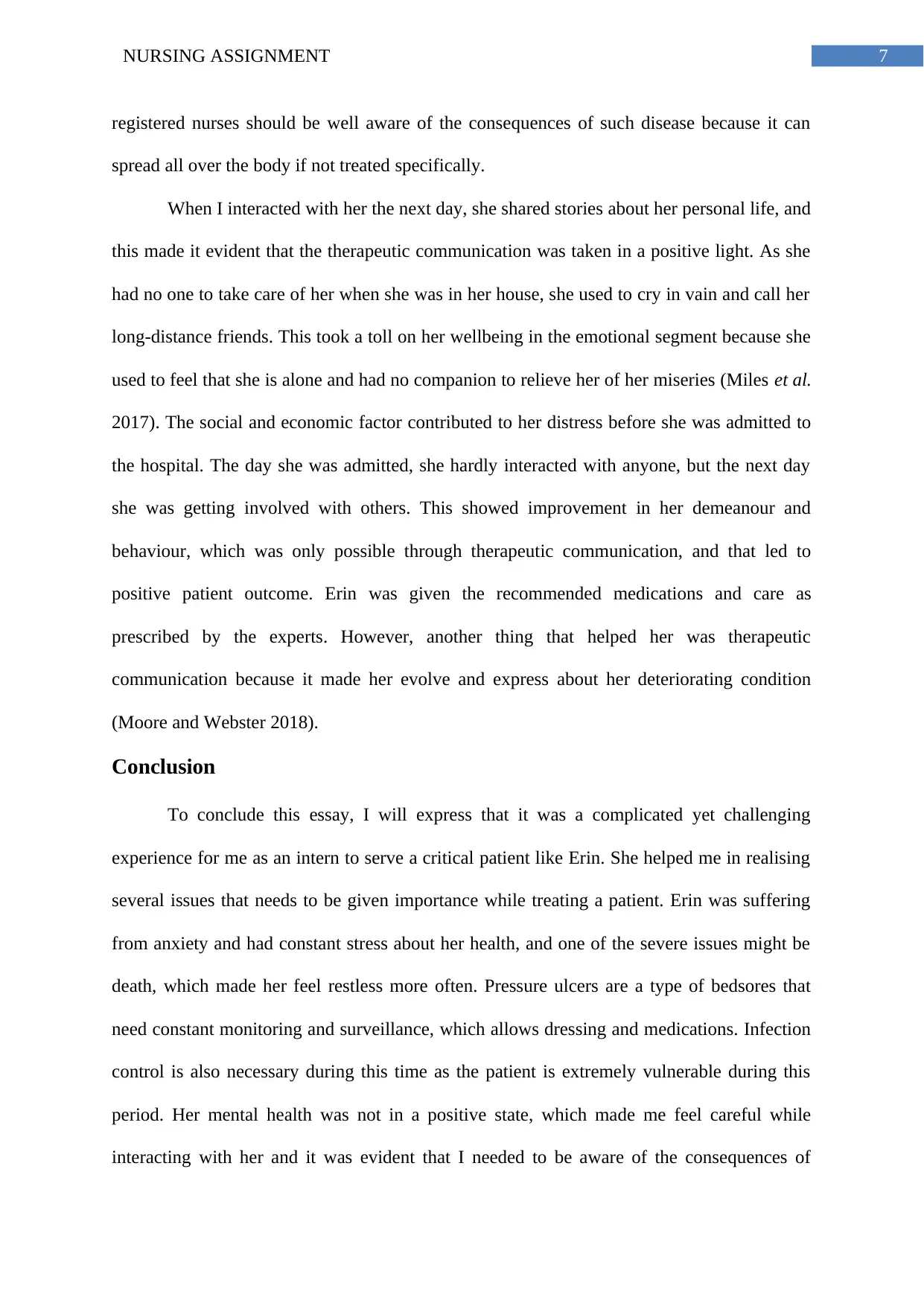
7NURSING ASSIGNMENT
registered nurses should be well aware of the consequences of such disease because it can
spread all over the body if not treated specifically.
When I interacted with her the next day, she shared stories about her personal life, and
this made it evident that the therapeutic communication was taken in a positive light. As she
had no one to take care of her when she was in her house, she used to cry in vain and call her
long-distance friends. This took a toll on her wellbeing in the emotional segment because she
used to feel that she is alone and had no companion to relieve her of her miseries (Miles et al.
2017). The social and economic factor contributed to her distress before she was admitted to
the hospital. The day she was admitted, she hardly interacted with anyone, but the next day
she was getting involved with others. This showed improvement in her demeanour and
behaviour, which was only possible through therapeutic communication, and that led to
positive patient outcome. Erin was given the recommended medications and care as
prescribed by the experts. However, another thing that helped her was therapeutic
communication because it made her evolve and express about her deteriorating condition
(Moore and Webster 2018).
Conclusion
To conclude this essay, I will express that it was a complicated yet challenging
experience for me as an intern to serve a critical patient like Erin. She helped me in realising
several issues that needs to be given importance while treating a patient. Erin was suffering
from anxiety and had constant stress about her health, and one of the severe issues might be
death, which made her feel restless more often. Pressure ulcers are a type of bedsores that
need constant monitoring and surveillance, which allows dressing and medications. Infection
control is also necessary during this time as the patient is extremely vulnerable during this
period. Her mental health was not in a positive state, which made me feel careful while
interacting with her and it was evident that I needed to be aware of the consequences of
registered nurses should be well aware of the consequences of such disease because it can
spread all over the body if not treated specifically.
When I interacted with her the next day, she shared stories about her personal life, and
this made it evident that the therapeutic communication was taken in a positive light. As she
had no one to take care of her when she was in her house, she used to cry in vain and call her
long-distance friends. This took a toll on her wellbeing in the emotional segment because she
used to feel that she is alone and had no companion to relieve her of her miseries (Miles et al.
2017). The social and economic factor contributed to her distress before she was admitted to
the hospital. The day she was admitted, she hardly interacted with anyone, but the next day
she was getting involved with others. This showed improvement in her demeanour and
behaviour, which was only possible through therapeutic communication, and that led to
positive patient outcome. Erin was given the recommended medications and care as
prescribed by the experts. However, another thing that helped her was therapeutic
communication because it made her evolve and express about her deteriorating condition
(Moore and Webster 2018).
Conclusion
To conclude this essay, I will express that it was a complicated yet challenging
experience for me as an intern to serve a critical patient like Erin. She helped me in realising
several issues that needs to be given importance while treating a patient. Erin was suffering
from anxiety and had constant stress about her health, and one of the severe issues might be
death, which made her feel restless more often. Pressure ulcers are a type of bedsores that
need constant monitoring and surveillance, which allows dressing and medications. Infection
control is also necessary during this time as the patient is extremely vulnerable during this
period. Her mental health was not in a positive state, which made me feel careful while
interacting with her and it was evident that I needed to be aware of the consequences of
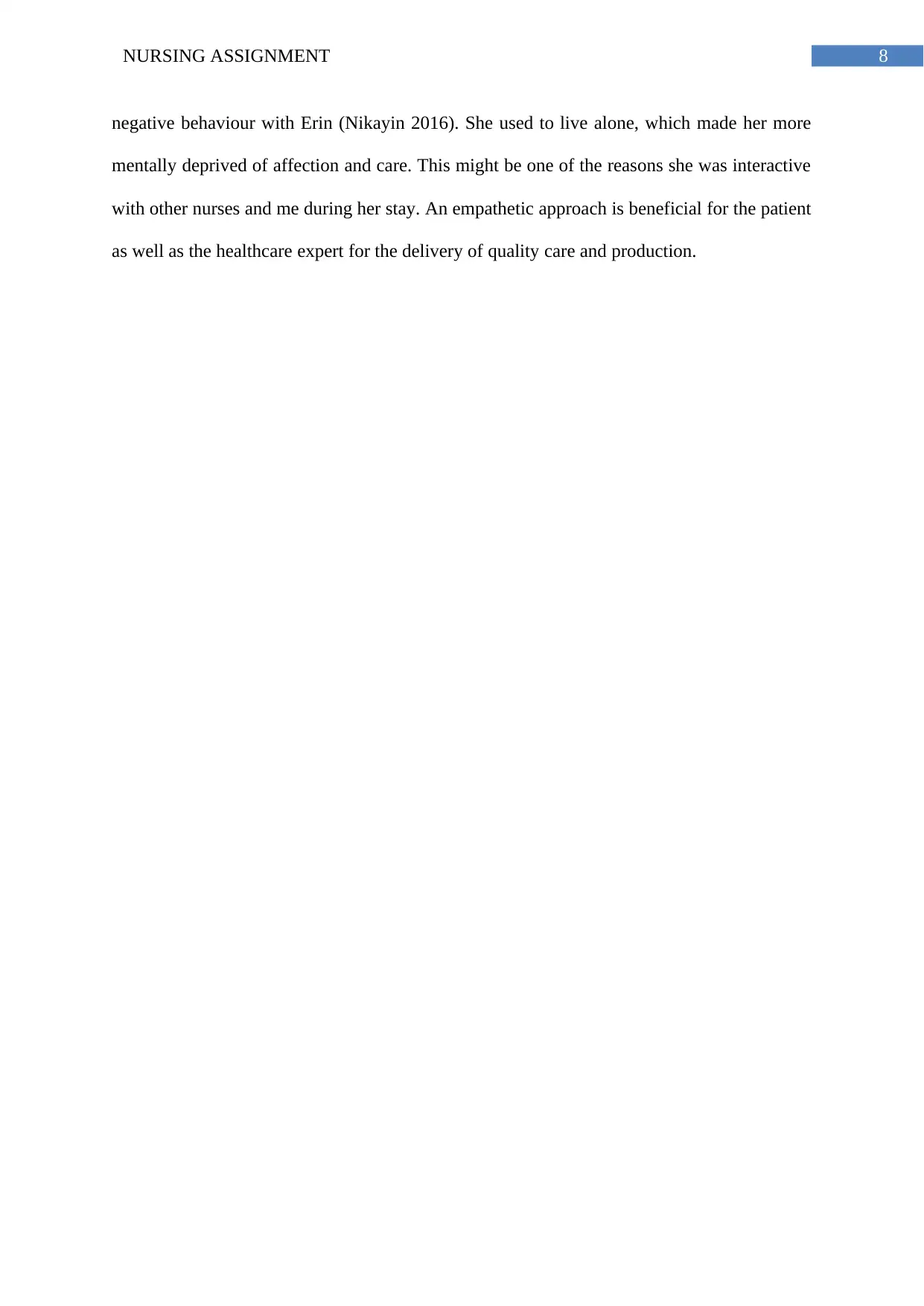
8NURSING ASSIGNMENT
negative behaviour with Erin (Nikayin 2016). She used to live alone, which made her more
mentally deprived of affection and care. This might be one of the reasons she was interactive
with other nurses and me during her stay. An empathetic approach is beneficial for the patient
as well as the healthcare expert for the delivery of quality care and production.
negative behaviour with Erin (Nikayin 2016). She used to live alone, which made her more
mentally deprived of affection and care. This might be one of the reasons she was interactive
with other nurses and me during her stay. An empathetic approach is beneficial for the patient
as well as the healthcare expert for the delivery of quality care and production.
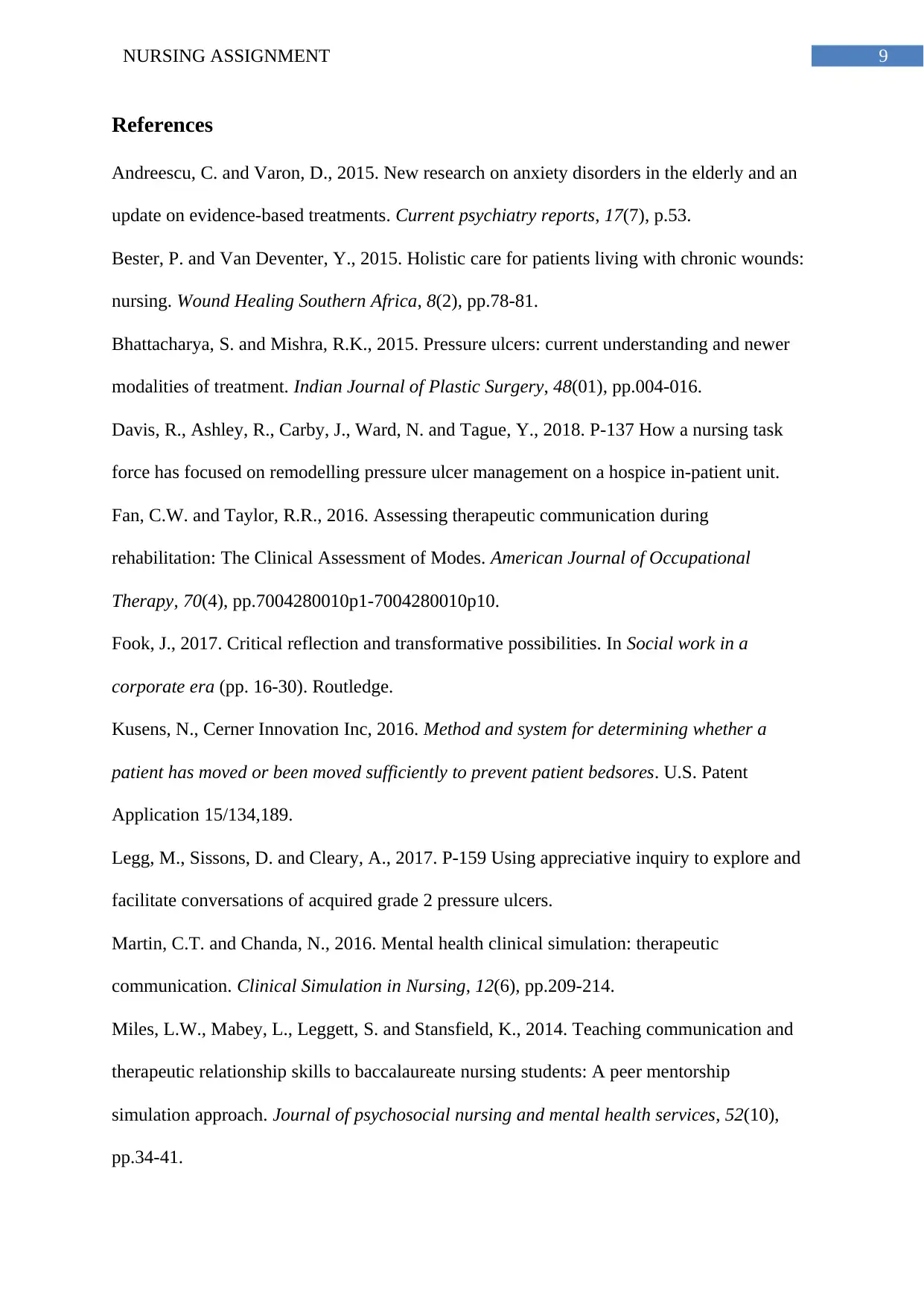
9NURSING ASSIGNMENT
References
Andreescu, C. and Varon, D., 2015. New research on anxiety disorders in the elderly and an
update on evidence-based treatments. Current psychiatry reports, 17(7), p.53.
Bester, P. and Van Deventer, Y., 2015. Holistic care for patients living with chronic wounds:
nursing. Wound Healing Southern Africa, 8(2), pp.78-81.
Bhattacharya, S. and Mishra, R.K., 2015. Pressure ulcers: current understanding and newer
modalities of treatment. Indian Journal of Plastic Surgery, 48(01), pp.004-016.
Davis, R., Ashley, R., Carby, J., Ward, N. and Tague, Y., 2018. P-137 How a nursing task
force has focused on remodelling pressure ulcer management on a hospice in-patient unit.
Fan, C.W. and Taylor, R.R., 2016. Assessing therapeutic communication during
rehabilitation: The Clinical Assessment of Modes. American Journal of Occupational
Therapy, 70(4), pp.7004280010p1-7004280010p10.
Fook, J., 2017. Critical reflection and transformative possibilities. In Social work in a
corporate era (pp. 16-30). Routledge.
Kusens, N., Cerner Innovation Inc, 2016. Method and system for determining whether a
patient has moved or been moved sufficiently to prevent patient bedsores. U.S. Patent
Application 15/134,189.
Legg, M., Sissons, D. and Cleary, A., 2017. P-159 Using appreciative inquiry to explore and
facilitate conversations of acquired grade 2 pressure ulcers.
Martin, C.T. and Chanda, N., 2016. Mental health clinical simulation: therapeutic
communication. Clinical Simulation in Nursing, 12(6), pp.209-214.
Miles, L.W., Mabey, L., Leggett, S. and Stansfield, K., 2014. Teaching communication and
therapeutic relationship skills to baccalaureate nursing students: A peer mentorship
simulation approach. Journal of psychosocial nursing and mental health services, 52(10),
pp.34-41.
References
Andreescu, C. and Varon, D., 2015. New research on anxiety disorders in the elderly and an
update on evidence-based treatments. Current psychiatry reports, 17(7), p.53.
Bester, P. and Van Deventer, Y., 2015. Holistic care for patients living with chronic wounds:
nursing. Wound Healing Southern Africa, 8(2), pp.78-81.
Bhattacharya, S. and Mishra, R.K., 2015. Pressure ulcers: current understanding and newer
modalities of treatment. Indian Journal of Plastic Surgery, 48(01), pp.004-016.
Davis, R., Ashley, R., Carby, J., Ward, N. and Tague, Y., 2018. P-137 How a nursing task
force has focused on remodelling pressure ulcer management on a hospice in-patient unit.
Fan, C.W. and Taylor, R.R., 2016. Assessing therapeutic communication during
rehabilitation: The Clinical Assessment of Modes. American Journal of Occupational
Therapy, 70(4), pp.7004280010p1-7004280010p10.
Fook, J., 2017. Critical reflection and transformative possibilities. In Social work in a
corporate era (pp. 16-30). Routledge.
Kusens, N., Cerner Innovation Inc, 2016. Method and system for determining whether a
patient has moved or been moved sufficiently to prevent patient bedsores. U.S. Patent
Application 15/134,189.
Legg, M., Sissons, D. and Cleary, A., 2017. P-159 Using appreciative inquiry to explore and
facilitate conversations of acquired grade 2 pressure ulcers.
Martin, C.T. and Chanda, N., 2016. Mental health clinical simulation: therapeutic
communication. Clinical Simulation in Nursing, 12(6), pp.209-214.
Miles, L.W., Mabey, L., Leggett, S. and Stansfield, K., 2014. Teaching communication and
therapeutic relationship skills to baccalaureate nursing students: A peer mentorship
simulation approach. Journal of psychosocial nursing and mental health services, 52(10),
pp.34-41.
Secure Best Marks with AI Grader
Need help grading? Try our AI Grader for instant feedback on your assignments.
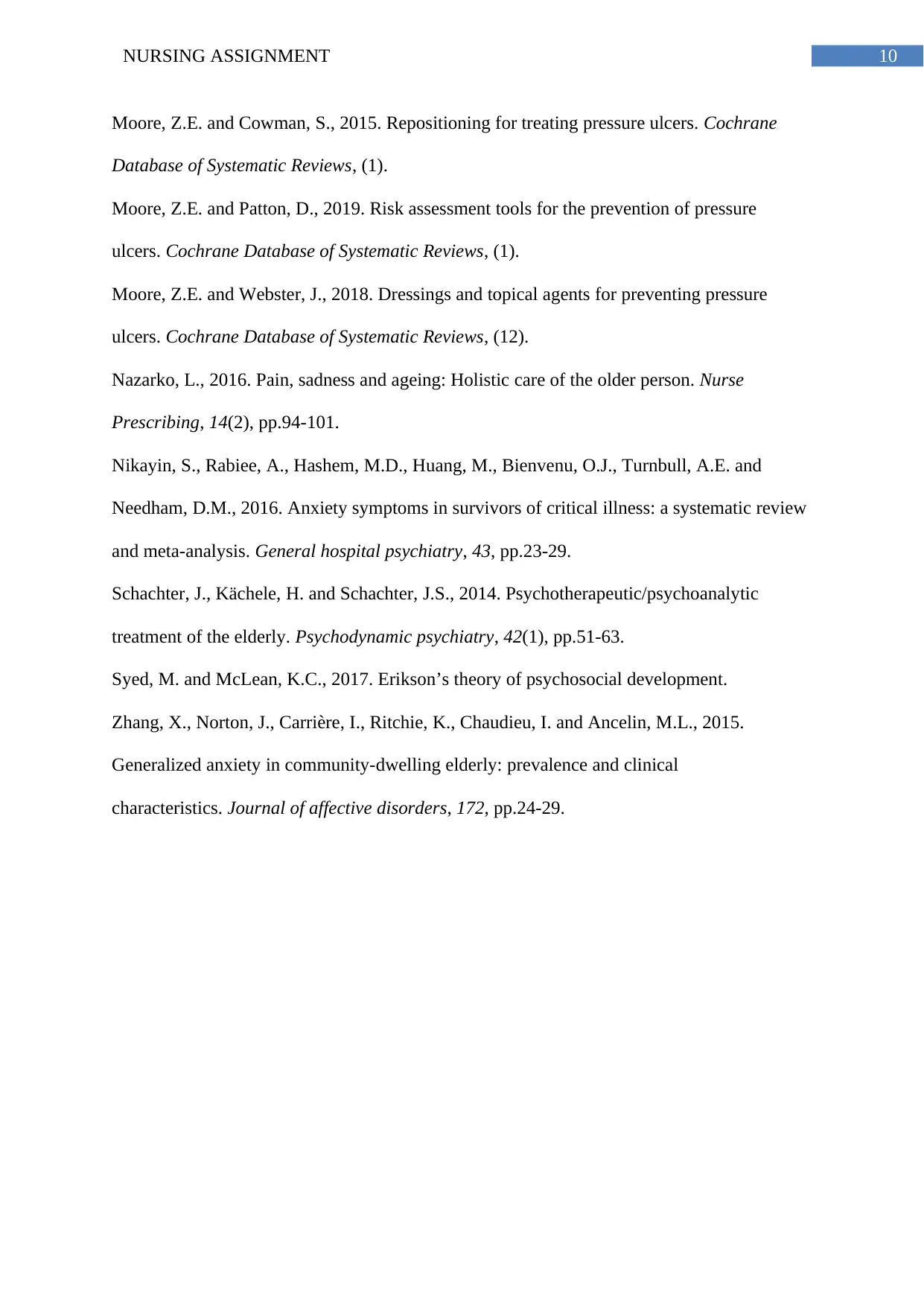
10NURSING ASSIGNMENT
Moore, Z.E. and Cowman, S., 2015. Repositioning for treating pressure ulcers. Cochrane
Database of Systematic Reviews, (1).
Moore, Z.E. and Patton, D., 2019. Risk assessment tools for the prevention of pressure
ulcers. Cochrane Database of Systematic Reviews, (1).
Moore, Z.E. and Webster, J., 2018. Dressings and topical agents for preventing pressure
ulcers. Cochrane Database of Systematic Reviews, (12).
Nazarko, L., 2016. Pain, sadness and ageing: Holistic care of the older person. Nurse
Prescribing, 14(2), pp.94-101.
Nikayin, S., Rabiee, A., Hashem, M.D., Huang, M., Bienvenu, O.J., Turnbull, A.E. and
Needham, D.M., 2016. Anxiety symptoms in survivors of critical illness: a systematic review
and meta-analysis. General hospital psychiatry, 43, pp.23-29.
Schachter, J., Kächele, H. and Schachter, J.S., 2014. Psychotherapeutic/psychoanalytic
treatment of the elderly. Psychodynamic psychiatry, 42(1), pp.51-63.
Syed, M. and McLean, K.C., 2017. Erikson’s theory of psychosocial development.
Zhang, X., Norton, J., Carrière, I., Ritchie, K., Chaudieu, I. and Ancelin, M.L., 2015.
Generalized anxiety in community-dwelling elderly: prevalence and clinical
characteristics. Journal of affective disorders, 172, pp.24-29.
Moore, Z.E. and Cowman, S., 2015. Repositioning for treating pressure ulcers. Cochrane
Database of Systematic Reviews, (1).
Moore, Z.E. and Patton, D., 2019. Risk assessment tools for the prevention of pressure
ulcers. Cochrane Database of Systematic Reviews, (1).
Moore, Z.E. and Webster, J., 2018. Dressings and topical agents for preventing pressure
ulcers. Cochrane Database of Systematic Reviews, (12).
Nazarko, L., 2016. Pain, sadness and ageing: Holistic care of the older person. Nurse
Prescribing, 14(2), pp.94-101.
Nikayin, S., Rabiee, A., Hashem, M.D., Huang, M., Bienvenu, O.J., Turnbull, A.E. and
Needham, D.M., 2016. Anxiety symptoms in survivors of critical illness: a systematic review
and meta-analysis. General hospital psychiatry, 43, pp.23-29.
Schachter, J., Kächele, H. and Schachter, J.S., 2014. Psychotherapeutic/psychoanalytic
treatment of the elderly. Psychodynamic psychiatry, 42(1), pp.51-63.
Syed, M. and McLean, K.C., 2017. Erikson’s theory of psychosocial development.
Zhang, X., Norton, J., Carrière, I., Ritchie, K., Chaudieu, I. and Ancelin, M.L., 2015.
Generalized anxiety in community-dwelling elderly: prevalence and clinical
characteristics. Journal of affective disorders, 172, pp.24-29.
1 out of 11
Related Documents
Your All-in-One AI-Powered Toolkit for Academic Success.
+13062052269
info@desklib.com
Available 24*7 on WhatsApp / Email
![[object Object]](/_next/static/media/star-bottom.7253800d.svg)
Unlock your academic potential
© 2024 | Zucol Services PVT LTD | All rights reserved.





